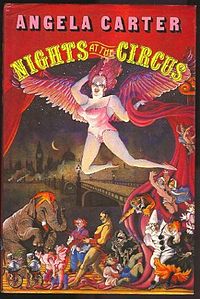"Something's happened to the park," my four year old called urgently as we approached the playground gates early one morning. He was right.
Carousels, bouncy castles and shut-up caravans had sprouted on the grass apparently without disturbing the dew. No one was about. My son walked around the perimeter path fascinated by the tents and stalls, but too awed to approach.
There's something magic about the way a circus or a funfair arrives quietly at night, while good citizens are asleep, and transforms a green space into a location for a temporary, invented world. A writer who knows a thing or two about that feeling is Erin Morgenstern, whose novel The Night Circus was published last year:
The circus arrives without warning.
No announcements precede it, no paper notices on downtown posts and billboards, no mentions or advertistements in local newspapers. It is simply there, when yesterday it was not.
 |
| Cover design for The Night Circus by Vania Zouravliov |
But it's also rare for a novel to have a title that's so similar to a classic, especially when its subject matter is also so close. Nights at the Circus by Angela Carter, first published in 1984, is one of my favourite books and a masterpiece of magic realism. Let's list some similarities with The Night Circus: apart from the title, both are set in the nineteenth century, both feature a travelling circus with magic properties, both centre on a romance, and both draw on fairy tales. But where Morgenstern's book is ultimately a fantasy romance, Angela Carter's book is a proper literary diamond.
 |
| First edition cover of Nights at the Circus by Roxanna Bikadoroff |
I would hate it if Angela Carter's novel were forgotten in all the hype for Morgenstern's book. So if you liked The Night Circus, for goodness sake read Nights at the Circus too. And if a big top arrives in a field near you, why not treat your inner four-year-old to a couple of hours suspension of disbelief and enjoy the carnival.

No comments:
Post a Comment